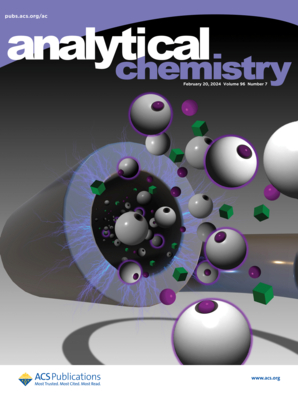将可编程二硫-炔反应集成到自下而上的蛋白质分析工作流程中,实现高覆盖率二硫绘图
IF 6.7
1区 化学
Q1 CHEMISTRY, ANALYTICAL
引用次数: 0
摘要
在药物开发和质量控制过程中,绘制二硫键图谱对于表征医药蛋白质至关重要。传统的自下而上蛋白质分析工作流程往往会出现由多个二硫键组成的胰蛋白酶肽图绘制不完整的问题。虽然采用部分还原二硫键的方法可以改善二硫键图谱的绘制,但由于经常需要进行个别调整,因此成为分析的瓶颈。在此,我们开发了一种在线二硫烯反应系统,可对反应溶剂的成分进行编程,以实现液相色谱分离后胰二硫肽的最佳部分还原。通过将该系统与自下而上的蛋白质分析工作流程相结合,对由 4-19 个二硫键组成的标准蛋白质实现了高覆盖率测序(71-83%)和二硫键图谱绘制(84-100%)。通过绘制溶菌酶中的 13 个乱序二硫键,以及对人血浆中的 IgG 同型(κ 和 λ)和亚类(IgG1-IgG4)进行成分分析,进一步证明了该系统的分析能力。本文章由计算机程序翻译,如有差异,请以英文原文为准。

High-Coverage Disulfide Mapping Enabled by Programmable Disulfide-Ene Reaction Integrated onto a Bottom-Up Protein Analysis Workflow
Mapping disulfide linkages is crucial for characterizing pharmaceutical proteins during drug development and quality control. Traditional bottom-up protein analysis workflows often suffer from incomplete mapping for tryptic peptides consisting of multiple disulfide bonds. Although the employment of a partial reduction of disulfide bonds can improve disulfide mapping, it becomes a bottleneck of analysis because individual tuning is often needed. Herein, we have developed an online disulfide-ene reaction system in which the composition of the reaction solvent can be programmed to achieve optimal partial reduction of tryptic disulfide peptides after liquid chromatography separation. By coupling this system onto a bottom-up protein analysis workflow, high coverage for sequencing (71–83%) and disulfide mapping (84–100%) was achieved for standard proteins consisting of 4–19 disulfide bonds. The analytical capability was further demonstrated by mapping 13 scrambled disulfide bonds in lysozyme and achieving compositional analysis of IgG isotypes (κ and λ) and subclasses (IgG1–IgG4) from human plasma.
求助全文
通过发布文献求助,成功后即可免费获取论文全文。
去求助
来源期刊

Analytical Chemistry
化学-分析化学
CiteScore
12.10
自引率
12.20%
发文量
1949
审稿时长
1.4 months
期刊介绍:
Analytical Chemistry, a peer-reviewed research journal, focuses on disseminating new and original knowledge across all branches of analytical chemistry. Fundamental articles may explore general principles of chemical measurement science and need not directly address existing or potential analytical methodology. They can be entirely theoretical or report experimental results. Contributions may cover various phases of analytical operations, including sampling, bioanalysis, electrochemistry, mass spectrometry, microscale and nanoscale systems, environmental analysis, separations, spectroscopy, chemical reactions and selectivity, instrumentation, imaging, surface analysis, and data processing. Papers discussing known analytical methods should present a significant, original application of the method, a notable improvement, or results on an important analyte.
 求助内容:
求助内容: 应助结果提醒方式:
应助结果提醒方式:


